Archive:Living standard statistics
- Data extracted in December 2016. Most recent data: Further Eurostat information, Main tables and Database. Planned update: November 2017.
This article focuses on living standards in the European Union (EU), as measured by the median equivalised disposable income. Living standards increased or remained stable in 24 EU Member States and fell in 4 EU Member States in 2015 compared with a year earlier, after adjusting for inflation. In 11 EU Member States the median income fell among the people in unemployment and only in 4 Member States in the case of the population of employees.
Income decreased in the bottom quintile of the income distribution in six EU Member States. Income inequality increased in nine EU Member States because the higher income quintiles decreased less or increased more than the lower income quintiles. Looking at the material conditions of households in 2015, 8.5 % of the EU population reported that they could not afford a meal with meat, chicken, fish or a vegetarian equivalent every second day. This represents a decrease of 1.0 percentage points (pp) compared with 2014.
All figures are based on the latest Statistics on income and living conditions (EU-SILC) data collected in 2015.
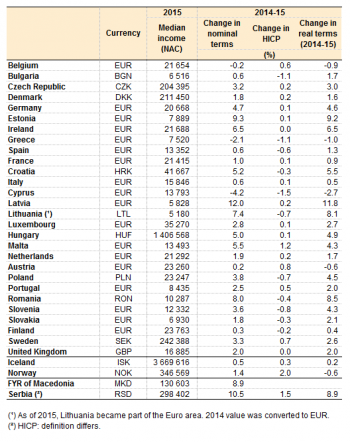
Source: Eurostat (ilc_di03) and (prc_hicp_aind)
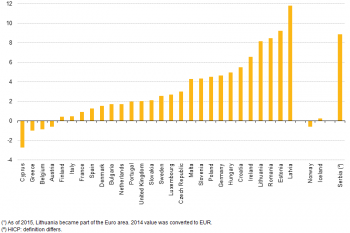
(%)
Source: Eurostat (ilc_di03) and (prc_hicp_aind)
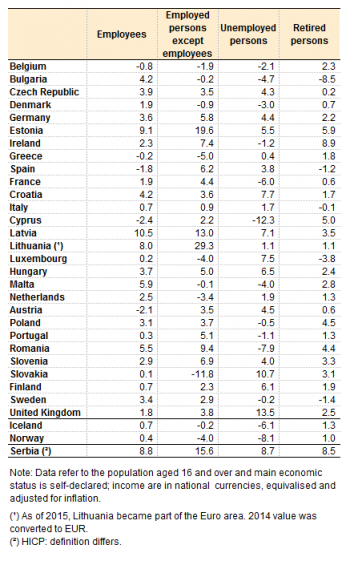
(%)
Source: Eurostat (ilc_di05) and (prc_hicp_aind)
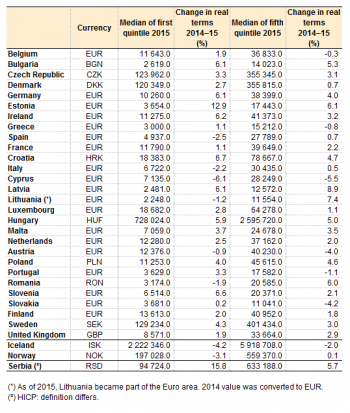
Source: Eurostat (ilc_di01) and (prc_hicp_aind)
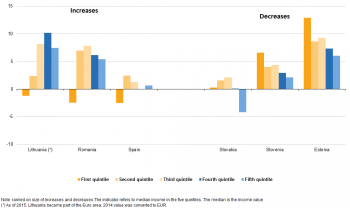
(%)
Source: Eurostat (ilc_di01) and (prc_hicp_aind)
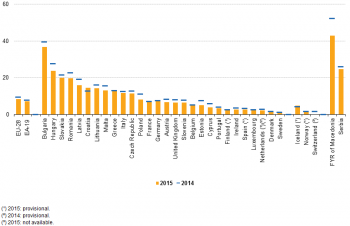
(% of total population)
Source: Eurostat (ilc_mdes03)
Main statistical findings
Household disposable income corresponds to income from market sources and cash benefits after deduction of direct taxes and regular inter-household cash transfers. It can be considered as the income available to the household for spending or saving. The living standards achievable by a household with a given disposable income depend on how many people and of what age live in the household.
Household income is thus ‘equivalised’ i.e. adjusted for household size and composition so that the incomes of all households can be looked at on a comparable basis. Equivalised disposable income is an indicator of the economic resources available to a standardised household. For a lone-person household it is equal to household income. For a household comprising more than one person, it is an indicator of the household income that would be needed by a lone person household to enjoy the same level of economic wellbeing. This income concept, based on the assumption of income sharing within the household, and of economies of scale resulting from living together, is used in this article.
The latest data, collected during 2016, include income for the reference period from 1 January to 31 December 2015 and non-income variables referring to 2014.
The median is the income value which divides a population, when ranked by income, into two equal-sized groups: exactly 50 % of people fall below that value and 50 % are above it. When analysing income, this is the measure most commonly used to represent average income because the highly skewed nature of the income distribution can lead to the very high incomes of a few having a disproportionate impact on the mean. Poverty thresholds are calculated on the basis of the median equivalised disposable income.
Median equivalised disposable income in national currencies fell in three EU Member States in nominal terms (without adjusting for inflation) in 2015 compared with a year earlier (see Table 1).
The sharpest drop occurred in Cyprus, where median income fell by 4.2 %. It increased the most in Latvia (12.0 %), Estonia (9.3 %), Romania (8.0 %) and Lithuania (7.4 %). However, nominal changes do not tell the whole story about income changes, as inflation should also be considered. Median incomes have thus been adjusted by the annual rate of change in the Harmonised Index of Consumer Prices (HICP) for 2014 to obtain real changes. After adjusting for inflation, median equivalised disposable income in national currencies fell in four EU Member States in 2015 compared with a year earlier (see Table 1 and Figure 1).
The sharpest drop in real terms occurred in Cyprus, where the median equivalised disposable income fell by 2.7 %, followed by Greece (– 1.0 %), Belgium (– 0.9 %) and Austria (– 0.6 %). Median income increased in real terms by less than 3.0 % in Finland, Italy, France, Spain, Denmark, Bulgaria, the Netherlands, Portugal, the United Kingdom, Slovakia, Sweden and Luxembourg. It increased from 3.0 to 6.0 % in the Czech Republic, Malta, Slovenia, Poland, Germany, Hungary and Croatia, while the highest increases were registered in Ireland (6.5 %), Lithuania (8.1 %), Romania (8.5 %), Estonia (9.2 %) and Latvia (11.8 %). Increases or decreases in median income can essentially be explained by changes in family situation, employment situation, the welfare system and taxes.
Median income fell most for the unemployed
The activity status presented in the analysis is self-declared as measured by EU-SILC. Data are presented for persons who declared their main activity status as being: employees, employed persons other than employees (e.g. self-employed), retired and unemployed.
The median equivalised disposable income for a specific category of persons has to be regarded in the household context as it is influenced also by the income of other persons in the household.
In 11 EU Member States, median equivalised disposable income fell in real terms for the unemployed in 2015 compared with 2014 (see Table 2). It fell by more than 7 % in Romania (– 7.9 %) and Cyprus (– 12.3 %). Median equivalised disposable income for the unemployed increased in the 17 remaining EU Member States, with Slovakia (+ 10.7%) and the United Kingdom (+ 13.5 %) displaying the highest increases.
The decrease in median income for the unemployed can partly be explained by the rise in long-term unemployment and by the fact that in most countries the unemployed only have access to unemployment benefits for a limited period of time. Changes in the benefit system in some countries could also be part of the explanation.
For the employees, the median income fell most in Cyprus (– 2.4 %), Austria (– 2.1 %) and Spain (– 1.8 %). On the other hand, the highest increases (by more than 5 %) were recorded in Latvia (+10.5 %), Estonia (+ 9.1 %), Lithuania (+ 8.0 %), Malta (+ 5.9 %) and Romania (+ 5.5 %).
Income fell most for employed persons other than employees in Slovakia (– 11.8 %), Greece (– 5.0 %) and Luxembourg (– 4.0 %).
For retired people, the steepest decreases were registered in Bulgaria (– 8.5 %) and in Luxembourg (–3.8 %) while the highest rises were in Ireland (+ 8.9 % and Estonia + 5.9 %). On the other hand the smallest income changes, were observed in Italy (– 0.1 %), the Czech Republic (+ 0.2 %), France and Austria (+ 0.6 % each) and Denmark (+ 0.7 %).
Effects of income changes on income inequalities
Median equivalised disposable income does not give a complete picture of changes across the income distribution. Table 3 shows the change in real terms between 2014 and 2015 for the first and fifth quintiles of the income distribution. As a basis for calculations, the median of the interval covered by each quintile is used, being a measure of the average situation in each quintile.
In the bottom quintile, income decreased from 2014 to 2015 in six EU Member States after adjusting for inflation. The sharpest fall occurred in Cyprus, where the median income decreased by 6.1 %, followed by Spain (– 2.5 %). It increased the most in Estonia (+ 12.9 %), Croatia (+ 6.7 %) and Slovenia (+ 6.6 %).
In the top quintile, income also decreased in six EU Member States. Drops were registered Belgium (– 0.3 %), Greece (– 0.8 %), Portugal (– 1.1 %), Austria (– 4.0 %), Slovakia (– 4.2 %) and Cyprus (– 5.5 %). It increased the most in Latvia (+ 8.9 %), Lithuania (+ 7.4 %), Estonia (+ 6.1 %) and Romania (+ 6.0 %).
All in all, income inequality rose in 9 EU Member States, because income in the fifth quintile decreased less or increased more than in the first quintile. In order to explore in greater depth the effects of income changes on income inequalities we need to gain a better understanding of the income dynamics in different parts of the income distribution. For this purpose we divided countries into groups sharing similar characteristics in terms of changes in income in the first and fifth quintiles between 2014 and 2015.
In the first group (see Figure 2) composed of Lithuania, Romania and Spain, income decreased most in the lower quintiles and increased in the upper quintiles, thereby contributing to an increase in income inequality. This pattern was particularly clear (i.e. systematic over all quintiles) with the exception of Spain, where there was a slight decrease in income in the fourth quintile. In these three EU Member States, the higher income quintiles evolved much more favourably than the lower income quintiles, leading to an increase in the income inequality gap. Also in Latvia, Italy, France and the United Kingdom, the difference between the 2014-15 growth of the last and first quintiles was at least 1.0 pp.
In the second group (see Figure 2), composed of Slovakia, Slovenia and Estonia, income decreased most (or increased least) for the highest quintiles and decreased least (or increased most) in the lower quintiles, thereby contributing to a decrease in income inequality. This pattern was also visible to a lesser extent in Portugal, Austria, Ireland, Belgium, Germany, Croatia, Denmark, Greece, Luxembourg and Sweden.
In Poland, Cyprus, Malta, Finland, the Czech Republic, the Netherlands, Bulgaria and Hungary the evolution of the gap between the ends of the income distribution varied less than 1.0 pp.
Material deprivation
In 2015, 8.5 % of EU citizens could not afford a meal with meat, chicken, fish or a vegetarian equivalent every second day. Material deprivation complements the income perspective by providing an estimate of the proportion of people whose living conditions are severely affected by a lack of resources.
Among material deprivation items, the inability to afford a meal with meat, chicken, fish or a vegetarian equivalent every second day decreased by 1.0 pp in 2015 at EU-28 level compared with 2014 (see Figure 3). In 2015, as mentioned above, 8.5 % of the EU population reported that they could not afford this item — a decrease of 0.3 pp compared even with 2010 low of 8.8 %.
Looking at the EU Member States it appears that material deprivation is in some cases correlated with the decrease in income in the lowest quintiles. In 2015, the percentage of people reporting that they could not afford a meal with meat, chicken, fish or a vegetarian equivalent every second day ranged from 3.0 % or less in Finland, Ireland, Spain, Luxembourg, the Netherlands, Denmark and Sweden to 36.8 % in Bulgaria. The figures for the FYR of Macedonia and Serbia were also high, at 52.2 % (2014 data) and 24.6 % respectively.
Compared with 2014, the percentage of people reporting that they could not afford such a meal every second day increased by 1.8 pp in Croatia, 0.2 pp in Finland and by 0.1 pp in France and Sweden and at the same time it fell between 3.0 and 4.0 pp in Hungary, Latvia Poland and Romania.
Data sources and availability
The reference source for statistics and indicators on income and living conditions is EU-SILC (EU statistics on income and living conditions). This survey is organised under the Framework Regulation 1177/2003. EU-SILC is the main source of information used in the European Union to develop indicators monitoring poverty and social exclusion.
Definitions
Income: Gross income includes income from market sources and cash benefits. The former includes employee cash or near-cash income, non-cash employee income, cash benefits from self-employment, income from rental of property or land, regular inter-household cash transfers received, interest, dividends, profit from capital investments in unincorporated businesses, income received by people aged under 16 and pensions from individual private plans. Cash benefits are the sum of all unemployment, old-age, survivor’s, sickness and disability benefits; education-related, family/children-related and housing allowances; and benefits for social exclusion or those not elsewhere classified. Direct taxes and regular inter-household cash transfers paid are deducted from gross income to give disposable income.
The current definition of total household disposable income used for calculating the indicators presented excludes imputed rent — i.e. money that the household saves on full (market) rent by living in its own accommodation or in accommodation it rents at a price that is lower than the market rent. The definition of income currently used also excludes non-monetary income components, in particular the value of goods produced for own consumption, social transfers in kind and non-cash employee income except company cars.
Income reference period: The income reference period is a fixed 12-month period (such as the previous calendar or tax year) for all countries except the United Kingdom, for which the income reference period is the current year, and IE, for which the survey is continuous and income is collected for the last twelve months. The data used in this publication are derived from EU-SILC operation 2016. The income reference period is therefore 1 January 2014 to 31 December 2015. Data is compared with results from the previous data collection (2014).
Equivalised disposable income: In order to reflect differences in household size and composition, the income figures are given per equivalent adult. This means that the total household income is divided by its equivalent size using the ‘modified OECD equivalence scale’ and the resulting figure is allocated to each member of the household, whether adult or children. The scale gives a weight of 1.0 to the first adult, 0.5 to any other household member aged 14 and over and 0.3 to each child below the age of 14. The equivalent size of a household that consists of 2 adults and 2 children below the age of 14 is therefore: 1.0 + 0.5 + (2 x 0.3) = 2.1. Equivalised disposable income is therefore an indicator of the economic resources available to a standardised household. For a lone-person household it is equal to household income. For a household comprising more than one person, it is an indicator of the household income that would be needed by a lone-person household to enjoy the same level of economic wellbeing.
Inflation adjustment: In order to take account of inflation in year-to-year income changes we have used the HICP (Harmonised Index of Consumer Prices). The HICP is the consumer price index as it is calculated in the European Union, according to a harmonized approach and a single set of definitions.
Self-declared main economic status: Main economic status is self-defined and acquired by means of an EU-SILC target variable. This variable captures the person’s own perception of his or her main activity at the time of the survey. It differs from the ILO concept to the extent that people’s own perception of their main status differs from the strict definitions used in the ILO classifications of employment and unemployment. For instance, many people who would regard themselves as full-time students or homemakers may be classified by the ILO criteria as employed if they have a part-time job. Similarly, some people who consider themselves ‘unemployed’ may not meet the strict ILO criteria of taking active steps to find work and being immediately available.
Income quintiles: Quintiles refer to the position in the frequency distribution. The quintile cut-off value is obtained by sorting all incomes, from lowest to highest, and then choosing the value of income under which 20 % (lower limit), 40 % (second limit), 60 % (third), 80 % (fourth) and 100 % (upper limit) of the sample are located. A quintile as such is associated with the segment boundaries between two quintiles. The first segment includes income below the lower quintile cut-off (20 %), the second segment includes income located between the lower cut-off and the second quintile cut-off, and so on. In total, there are five segments. From these segments, the median income by quintile is calculated using cut-off points of 1st, 3rd, 5th, 7th and 9th deciles that correspond respectively to the median of 1st, 2nd, 3rd, 4th and 5th quintiles.
Inability to afford a meal: The severe material deprivation rate is defined as the percentage of the population with an enforced lack of at least four out of nine material deprivation items in the ‘economic strain and durables’ dimension. Not being able to afford a meal with meat, chicken, fish (or a vegetarian equivalent) every second day is one of the deprivation items.
EU-average: EU aggregates are computed as the population-weighted averages of national indicators.
Context
At the Laeken European Council in December 2001, European heads of state and government endorsed a first set of common statistical indicators of social exclusion and poverty; these are subject to a continuing process of refinement by the Indicators Sub-Group of the Social Protection Committee. These indicators are an essential element in the Open Method of Coordination to monitor the progress made by Member States in combating poverty and social exclusion.
EU-SILC was set up to provide the underlying data for these indicators. Organised under a Framework Regulation 1177/2003, it is now the reference source for statistics on income and living conditions and for common indicators for social inclusion in particular.
Under the Europe 2020 agenda, the European Council adopted in June 2010 a headline target on social inclusion. EU-SILC is also the reference source for the three sub-indicators on which this new target is based.
See also
- Living standards falling in most Member States Statistics in focus 8/2013
- Archive: Living standard statistics - incomes in 2010 (Statistics in focus 8/2013)
- Income distribution statistics
- Income inequality statistics
Further Eurostat information
Publications
- Quality of life - Facts and views
- Income and living conditions in Europe — 2014 edition — Statistical book
Main tables
Database
- Income and living conditions (ilc)
- Income distribution and monetary poverty (ilc_ip)
- Distribution of income (ilc_di)
- Material deprivation (ilc_md) (Implementation of changes in variables)
- Income distribution and monetary poverty (ilc_ip)
- Harmonised indices of consumer prices (HICP) (prc_hicp)
- HICP (2005 = 100) — annual data (average index and rate of change) (prc_hicp_aind)
Dedicated section
Methodology / Metadata
- EU statistics on income and living conditions (EU-SILC) methodology
- Measuring material deprivation in the EU Methodologies and Working Papers
- ESSPROS Manual and user guidelines — 2012 edition Methodologies and Working Papers
<noprint>=== Source data for tables, figures and maps (MS Excel) ===
Other information
- Regulation (EC) No 1177/2003 of 16 June 2003 concerning Community statistics on income and living conditions (EU-SILC)
- Regulation (EC) No 1737/2005
- Directive 2003/86/EC
- Commission Decision 2003/86/EC
Notes